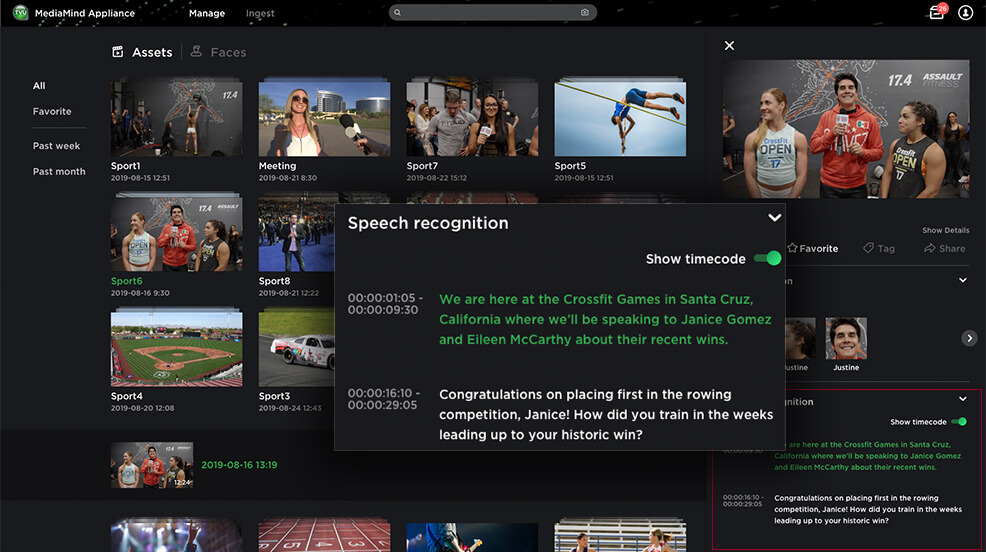Gone is the need to scrub back and forth through video to get to the precise in and out points of desired video clips. With the assistance of the speech-to-text algorithm available as part of our TVU MediaMind AI engine, it is now possible to jump instantly and precisely to the desired clips that correspond to the quotes from the video transcript....

What to Consider When Deciding on a Digital Asset Management (DAM) System
By Paul Shen, TVU Networks
August 18th, 2020
What is Digital Asset Management (DAM)?
TV station groups, networks and others in the M&E industry have struggled for years to find a way to get to their media assets fast and without thinking about where a desired asset is stored.
The problem is they are awash in the video footage, audio, graphics and animation needed to make TV. Making matters worse is there’s no slowdown in the growth of how many assets need to be stored and accessed—ideally in an instant.
Many have turned to Media Asset Management (MAM) and Digital Asset Management (DAM) systems to help.
A recent study finds across the globe the DAM market is expected to grow to $5.6 billion by 2022, an 18% annual compounded rate from the $2.44 billion market value in 2017.
Granted, M&E isn’t the only industry represented in these numbers, but it is a high-growth segment –among others like consumer goods and retail, healthcare and life sciences.
The DAM Problem
DAMs and MAMs are fine as far as they go. But when used for production storage, most people find that these storage systems –whether on premise or in the cloud—aren’t too helpful in navigating to stored media and finding what’s desired.
Further, because of how metadata typically is used to catalog video files and other media assets, what these systems provide is access to a file—not the specific frames in a file that an editor, for example, needs for the project at hand.
When it comes to projects that need fast turnarounds, such as news creation, these systems can impede speedy production, not enable it.
Being first is right up there with being accurate when it comes to building a reputation with the public as the go-to source for breaking TV news. If it takes too long to get a story ready for air –or digital distribution—because retrieving the needed clip from a MAM or DAM is slow and cumbersome, that’s a problem.
The Missing Puzzle Piece
None of this is to say and DAMs and MAMs can’t help, but to date there’s an important piece of the puzzle that’s been missing: discoverability.
Key to being discoverable is assigning metadata to each frame of video in a file. With that metadata, the same editor who would have had to inspect an entire file for the precise snippet needed in a story can search directly for the desired clip and retrieve it in a matter of seconds.
In fact, media organizations deploying our TVU MediaMind artificial intelligence (AI) engine can expect content stored on a MAM or DAM to be discoverable within 10 seconds of ingest—a huge competitive advantage for newsrooms.
An important related benefit is the ability to rethink provisioning bandwidth to transport video packets whether on premise or in the cloud. For instance, with the ability to access the precise 20 seconds of an interview that’s needed for an edited story rather than the entire file in which it resides, a broadcaster can dramatically reduce bandwidth requirements and in many instances get by with existing network resources.
Unlocking True Value
Beyond the immediate workflow at a given station involving a given news editor, making media assets easily and quickly discoverable offers benefits for all of the stations in a station group, network news bureaus and newsrooms and even M&E entities that have nothing whatsoever to do with news.
For station groups and networks, the ability to identify specific desired clips –not just locally—but across all stations, bureaus and newsrooms across the country or around the world means journalists can produce better stories in record time.
For TV sports and entertainment producers, this same capability translates into better, faster workflows. For both news and non-news organizations alike, having this ability to assign metadata to each frame of video and thereby make each frame discoverable means there’s an opportunity to generate revenue where there once was none.
Making media assets stored on a MAM or DAM in the cloud or on premise unlocks the hidden value of clips long-ago forgotten or simply too hard to find to be useful.
Once an asset can reliably and quickly be found, the door opens to new opportunities to license content to other organizations, giving every M&E enterprise with an archive the chance to generate new monies.